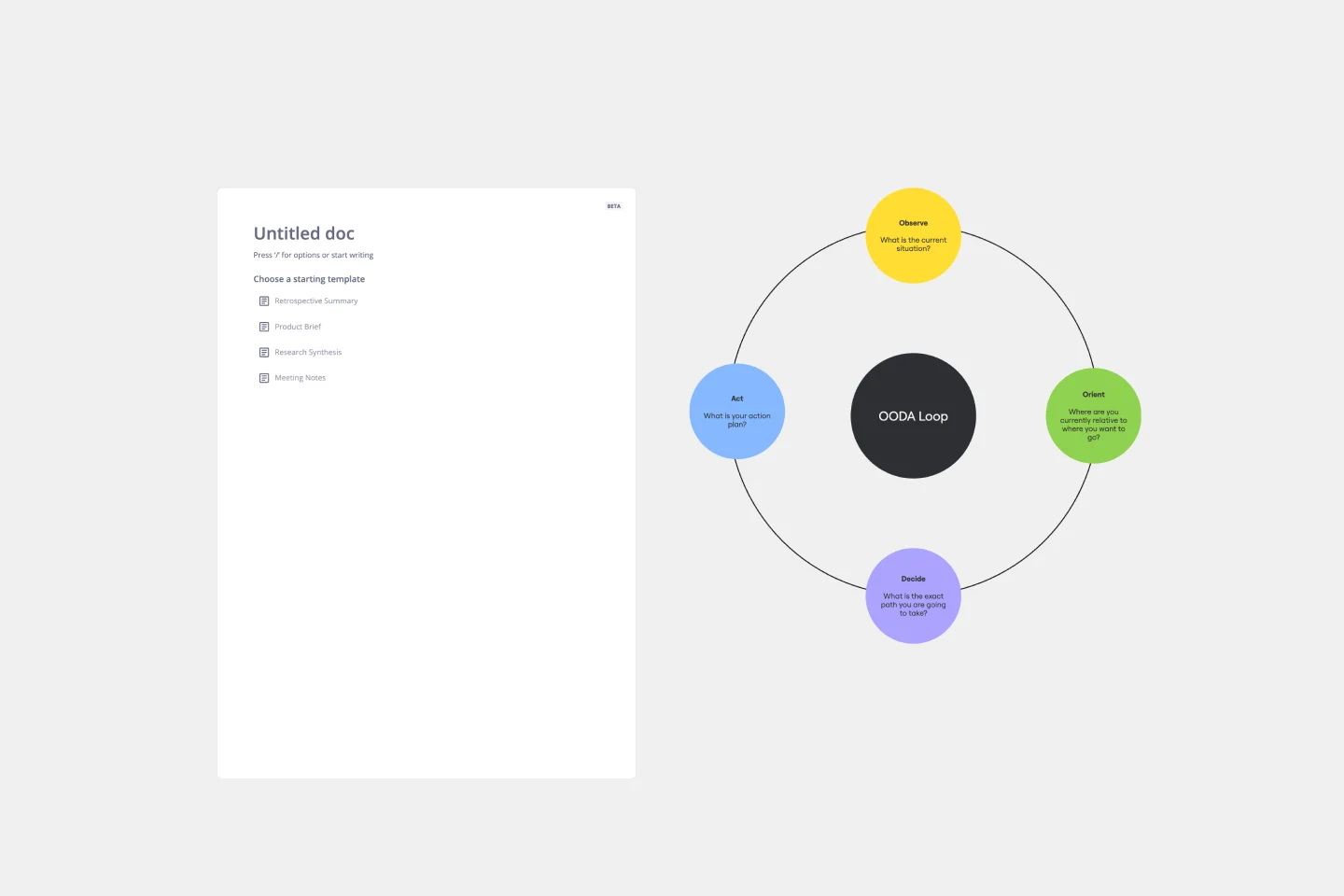About the Cycle Diagram Template
The cycle diagram template helps you streamline visual communication by mapping project cycles, illustrating process flows, or visualizing interconnected concepts. With this template, you can create compelling and insightful diagrams that will help you communicate your ideas more effectively.
Understanding the cycle diagram template
Cycle diagrams are a great way to visually represent processes, relationships, or events in an organized manner. They provide a structure that easily depicts the continuous flow and interdependence of elements within a system. You can simplify complex concepts using cycle diagrams, making it an invaluable asset for anyone seeking clarity in their visual storytelling.
How to use the cycle diagram template in Miro
Customize with ease: Effortlessly edit the template by adding, removing, or rearranging elements with just a few clicks.
Automated diagramming: Leverage Miro's automated diagram maker to expand and enhance your cycle diagram. Connect elements seamlessly, allowing the diagram to evolve dynamically as your ideas take shape.
Contextual artifacts: Elevate your diagram by incorporating additional artifacts from your Miro board. Whether it's notes, images, or data, provide context that enriches the understanding of your audience.
Why should you use a cycle diagram template?
Clarity and understanding: The template promotes clarity, enabling you to communicate complex processes with simplicity.
Efficiency in visualization: Quickly map out cyclical relationships and processes, saving time and effort in creating visually impactful diagrams.
Collaborative advantage: Enhance collaboration by creating a shared visual language that fosters clear communication among team members.
Versatility: The template adapts to various contexts, making it suitable for project management, strategic planning, or educational purposes.
Professional Presentation: Elevate your presentations and reports with professionally crafted cycle diagrams that resonate with your audience.
Cycle Diagram Template FAQs
Can I change the colors and styles of the cycle diagram template?
Achieve your desired look by customizing the template with ease. Adjust colors, fonts, and styles by selecting shapes and editing in the context menu bar.
Can I export the cycle diagram to other formats?
Yes, Miro allows you to export your cycle diagram in various formats, ensuring compatibility with your preferred tools and platforms.

Miro
Your virtual workspace for innovation
Miro is an innovation workspace designed for teams of every size, everywhere, to dream, design, and build the future together. Our mission? To empower these teams to create the next big thing, powered by AI at every step of the way. Over 90 million users around the world rely on Miro to untangle complex ideas, put customer needs first, and deliver products and services faster. All supported by best-in-class security, compliance, and scalability.
Categories
Similar templates
OODA Loop Template

OODA Loop Template
The OODA Loop template helps optimize decision-making processes by using four key stages- Observe, Orient, Decide, and Act. Its well-structured layout allows teams to systematically break down complex decisions, leading to a shared understanding of the decision-making workflow. One of the key benefits of the template is its ability to enhance collaboration. Teams can seamlessly contribute to and iterate upon the decision-making cycle in real time, resulting in more informed decisions and a more efficient process. The template provides a clear and visual representation of each stage, accelerating the decision-making process and fostering a collaborative environment where teams can work together to navigate challenges and make well-informed decisions.
PDCA Template

PDCA Template
The PDCA template provides a visually compelling representation of the Plan-Do-Check-Act cycle, a foundational management methodology. Structured around four primary segments, this template helps teams systematically address challenges, test solutions, assess outcomes, and make necessary refinements. Using the PDCA template fosters continuous improvement. By cycling through each phase repeatedly, organizations can perpetually refine their strategies, ensuring they always move towards optimal solutions and processes.
OODA Loop Template

OODA Loop Template
The OODA Loop template helps optimize decision-making processes by using four key stages- Observe, Orient, Decide, and Act. Its well-structured layout allows teams to systematically break down complex decisions, leading to a shared understanding of the decision-making workflow. One of the key benefits of the template is its ability to enhance collaboration. Teams can seamlessly contribute to and iterate upon the decision-making cycle in real time, resulting in more informed decisions and a more efficient process. The template provides a clear and visual representation of each stage, accelerating the decision-making process and fostering a collaborative environment where teams can work together to navigate challenges and make well-informed decisions.
PDCA Template

PDCA Template
The PDCA template provides a visually compelling representation of the Plan-Do-Check-Act cycle, a foundational management methodology. Structured around four primary segments, this template helps teams systematically address challenges, test solutions, assess outcomes, and make necessary refinements. Using the PDCA template fosters continuous improvement. By cycling through each phase repeatedly, organizations can perpetually refine their strategies, ensuring they always move towards optimal solutions and processes.